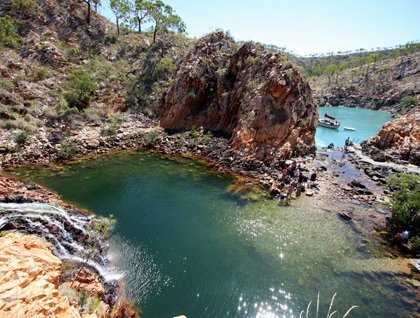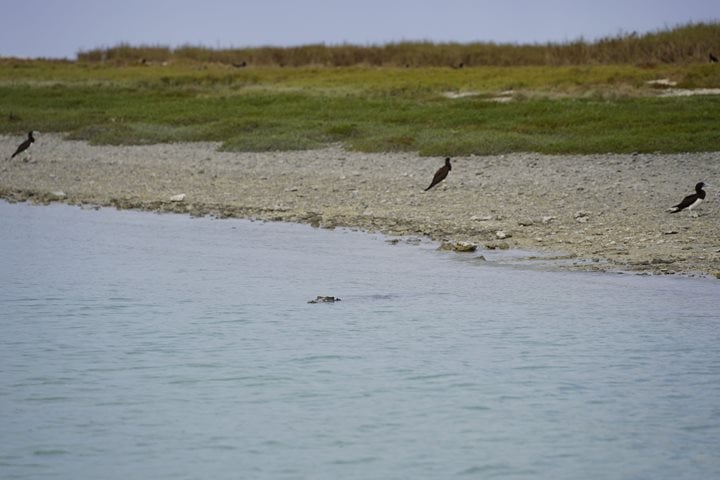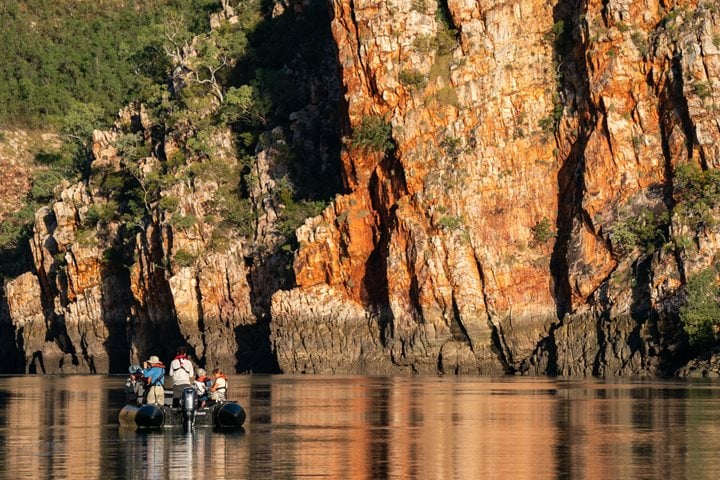Sailing out of Broome to start our journey along the coast of the Kimberly region last night had many a conversation speculating about the coming days’ sights and the experience in store for this expedition along this remote stretch of nearly pristine coastline. After all, it is a destination not easily reached and one that requires a substantial amount of travel, even for those from Australia and even more so for those venturing in from across the Pacific. Would the journey ahead be worth all the effort, taxis, planes and hotels required? Well, if today is any indication, the answer is an emphatic and indisputable “yes!”
We awoke to find the National Geographic Orion nestled in Yampi Sound, a name likely originating from the Aboriginal word “yampee,” meaning “water.” Water would be the theme of the day and as with most any ocean voyage, will likely be a recurring note throughout our journey here in the Kimberly region. The water beckons with its azure canvas and suggestive cool embrace. The water awes with the incredible tides that sculpt and nourish this coastline. The water seemingly forgives and forgets this coastline and its inhabitants as the rains abandon and literally flood the region during its two seasons, the Wet and the Dry. In short, the water here will define our adventure here for the duration of our journey.
Fitting then, our first day and indeed our first activity offered a sort of baptism into the spirit of the Kimberly with a chance to immerse ourselves in a secretive gem: the swimming hole at Crocodile Creek. This tranquil spot, likely “discovered” by local miners who use the waters here for their own recreation, sits hidden behind some of the folds of this coastline but gave us a chance to swim without fear of the saltwater crocodile. The name of the creek cascading down into the pool and then eventually into the sea, is thought to come from the jagged outline of the coastal headland and not from the presence of the fearsome animal. We swam beneath falls, some of us surprised by the thermocline found within the pool; the cool freshwater sitting on top of the warmer sea water that inundates the pool during the highest tides. Keen observers might have also noted the presence of a few local jellyfish surprisingly devoid of stingers not needed in this protected lagoon.
After our swim, we returned to the vessel for lunch and a change of clothes before setting out once more in our fleet of Zodiacs for a cruise through other parts of the sound: around Nares Point, Cockatoo Island, and the pre-historic cave site on Koolan Island. The shoreline here displays the incredible geology we will see throughout the Kimberly: the uplifted sea floor and compressed into the beautiful, iron-rich sandstones that so perfectly demonstrate the enormous pressure involved in the formation of this remarkable landscape. As we traveled along coast of tortured stone sculptures, we also encountered a nesting eastern osprey, a sooty oystercatcher, a few little corellas, and quite remarkably, a small pod of false killer whales that were quite interactive with two of the Zodiacs.
As the sun began to set and the evening star came into view over a placid sea, it could be asked if there is a need to venture elsewhere, but if each day forward offers the sublime scenery equal to that of today, we are in for an incredible experience indeed.







